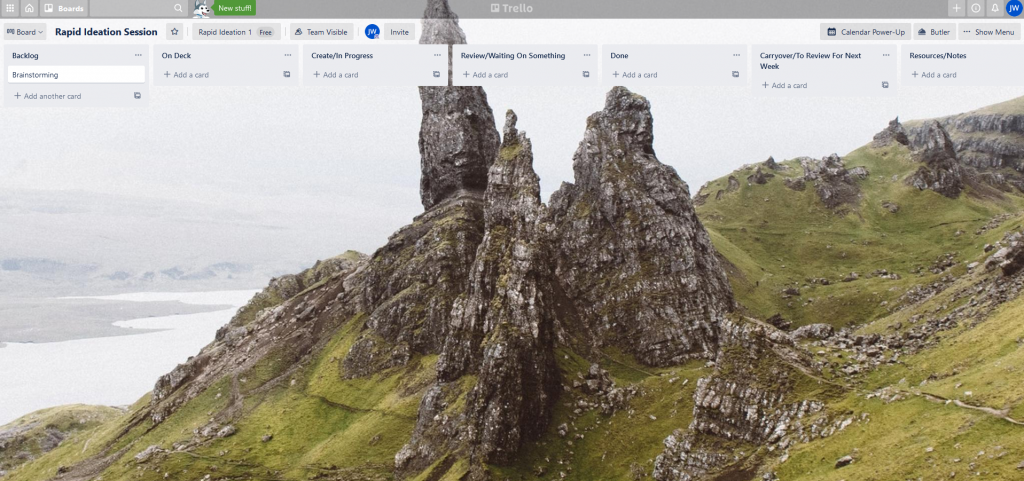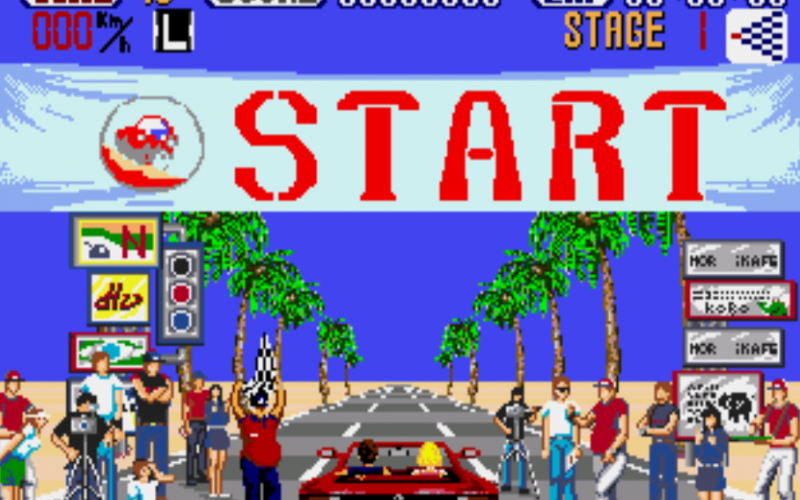The rapid ideation session is going to begin during tonight’s online seminar. As some final preparation ahead of this two week session, I have watched two videos on Canvas which had some useful tips for game jamming. These videos were hosted by Martin Cooke, a senior lecturer on the BA (Hons) Digital Games degree at Falmouth (Cooke, M., 2020).
While these videos were mostly focusing on game jams that involve working in groups and jams which last around 72 hours – the standard length for a game jam – there are plenty of useful points that I took from it, that I apply to my practice during the next two weeks.
What is a game jam good for?
The short, time constraned nature of game jams mean that they are great for learning to complete projects, as many bigger games with a longer schedule often do not get complete, possible due to lack of adequate or rigid scheduling, poor organisation or just simply running out of steam. The short time frame of game jams, which can last anywhere from 1 hour to 1 month allows participants to develop games in a short timeframe and to understand how scheduling for games works.
Game jams offer and opportunity to practice what I already know and also to explore different areas of game development, as well as gaining feedback and constructive, unbiased criticism from strangers across the game development community.
Skills and tools
While attempting this rapid ideation session, as well as with game jams in general, it is important that I use skills and tools that I already feel confident with. Cooke recommends that if we want to use a new tool or skill during a jam, that we get familiar with it at least a week before the jam. For this rapid ideation session, I do not have the opportunity to do this as it begins tonight but I can establish some skills that I will be able to bring, as well as tools that I will choose to use.
While I cannot profess full proficiency with any game engine yet, the game engine I am most familiar with is Unity and therefore I will most likely use this to build my game. I also have RPG Maker, Godot and GameMaker on my computer but its unlikely I will use these. I do not have enough experience with Godot or GameMaker so I will avoid using them. I am fairly confident with RPG Maker but while it is very powerful, moreso than it is given credit for, (Eurogamer.net. 2018) it may not suit the type of game that I choose to make for this project.
Other skills I possess that I can bring to this project include illustration and I am confident using the Adobe Creatvie Suite to produce sprites and animations. If I decide to go down the 16-bit pixel route, I may also consider using GraphicsGale.
This should also be an opportinity to develop exisiting skills, as Cooke mentions in his video. I have some experience using Blender to produce 3D graphics, which I may consider if I want to make a 3D game. I will most likely decide on the style and graphics during the brainstorming stage before I decide to bring in Blender.
Ideas
The session is entirely about generating ideas and developing them into finished pieces. Cooke gave a lot of ideas about creating and selecting ideas for a game jam. He advises never to go with our first idea, as it is unlilkely to be our best. He says that we should give extra time for brainstorming as many ideas as we can, as well as weighing up the pros and cons of each of these ideas.
I fully intend to implement this during my brainstorming stage. I will also, in addition write down the pros and cons of each idea both in terms of how much the idea appeals to me but also the practicality and feasibility of carrying out the idea. In the brainstorming stage, I will also consider, but not necessarily finalise, the genres and styles of game that each idea would suit.
While I will begin my brainstorming by using Alex Osborn’s method that I analysed in my 4th February post, I will then refine my ideas by visualising them and using methods such as mind mapping and I will also use elements from methods such as collaging (Bredowu, M., n.d). I analysed and came to recognise the virtues of visualising my ideas in my 5th February post, both in terms of understanding the workload and scope of the project, as well as refining and exploring styles for the finished product and I will carry over what I learnt to this project.
Cooke advises that when we pick an idea, we cut away as much from it as possible. We reduce this down to size until there is nothing more that can be taken out without losing the essence. Once this has been done, the idea should be small enough, yet exciting enough for a game jam project. It is easier to add content later than it is to have to sacrifice content later because its not practical or I do not have time.
Self-care
Self care is very important. Cooke advises that even during an intense session such as a game jam or a rapid ideation session that we take care of ourselve and continue to eat and sleep properly. I need to ensure I stick to this so that I can be as productive as I can and not become ill. I will also take regular breaks as this will allow me the time to reflect on what I have done so far.
Community
Cooke advises us to enagage with the gamedev community, as well as to be part of it and embrace it. I fully intend to do this and I realise that I will at times need to call on them for help as well as for their critique of my work. As a creative it is fundamenally important that we belong to community of fellow creatives, either virtual or IRL as this helps us to stay motivated, support one another and thrive together.
Agile / Scrum and Trello
This last part of the post will address how I will manage this project. I have decided that I will use Scrum as a means to manage the project and organise the assets within that project. To set up my project according to the Scrum framework, I will be using the thorough research I conducted on Scrum but I will also be using this document for quick reference (Scrum.org. n.d). Given the size and length of this project, I will be required to make some modifications to the standard Scrum process to make it more manageable for this particular project.
It is likely that I will be working on a solo project and therefore, the Scrum Team will only consist of one person – me. That means that I will be my own Scrum Master and Product Owner and it will be down to me alone to reflect on the project and what I will do to ensure that it is fully realised.
A project set up according to the Scrum framework is divided into several sprints, which each have a clear concise goal based on the stage of the product development life cycle. On average, a sprint lasts around 2 weeks. As this rapid ideation session will only last two weeks, I have decided that this project will consist of one sprint only and the entire production of the game will come under this sprint.
Scrum projects normally consist of a product backlog, which is an ordered list of tasks and assets to be completed, as well as a sprint backlog, which takes tasks from the product backlog that are relevant to a given sprint and then sorts them visually according to their progress. As this project will consist of just one sprint, I envision that there will be a lot of overlap between the product and sprint backlog and I may even merge them into one.
The user stories that will create the tasks and assets to go in the product backlog will largely be generated during the brainstorm stage and when I have finalised my game idea.
As I am likely be working solo, I will not be having team meetings. Meetings, known as ‘Stand-up meetings’ are an important part of Scrum for reflecting on what has been acheieved, what has yet to be achieved and what potential obstacles are in the way. In lieu of proper Stand-up meetings, I will be posting a blog post for every day of this rapid ideation session to document my progress and at the beginning of these posts, I will answer three fundamental questions:
- What did I do yesterday?
- What do I intend to do today?
- What is blocking my progress?
I will then use the answers to these questions to inform my next set of actions to bring the project forward.
My Trello board
As I have mentions across many posts, the best way to track progress is by visualisation and I shall be using Trello to guide me when using the Scrum method of project management and organising all tasks within the product backlog.
To save time, I used a template for a Trello board called ‘Marketing Sprint Example’, which I came across in this article, which explains the benefits of usign Trello in Scrum project management (Joiner, B., 2018). The template was set up precisely to faciliate organising tasks according within sprint.
I have used this template to make my own Trello board, which can be found here and I will also add a link in the right hand side bar so that you can follow my progress.

I am not going to put a huge amount of work into this board quite yet as I am not fully sure what direction this project is going to go in. As the project develops, more tasks will be added to the board and there is a chance that some of the lists displayed above could be removed or changed as I see fit. But for now, I will start small and keep it as it is, but then I will iterate as I become more familiar.
The only task that I have added to the product backlog using Trello is ‘Brainstorming’, as that is the first priority.
Trello does have the option of colour co-ordinating and adding labels, but I will leave these for now until I have decided on a suitable way of using them for this project.
Goal
A Scrum project always has a clear and concise goal. While I do not yet know what product I am going to make at the end of this rapid ideation session and this will only become more apparent after the theme is revealed tonight, it is still necessary for me to decide on the goal for this project. The end goal for this rapid ideation session is to design and build a complete, working game within two weeks.
References
Bredowu, M., n.d. Design Kit. [online] Designkit.org. Available at: https://www.designkit.org/methods/collage [Accessed 17 February 2021].
Cooke, M., 2020. How to get involved in jamming. Available at: <https://flex.falmouth.ac.uk/courses/911/pages/week-4-on-jams-and-hackathons> [Accessed 17 February 2021].
Cooke, M., 2020. Tips for effective jamming. Available at: <https://flex.falmouth.ac.uk/courses/911/pages/week-4-on-jams-and-hackathons> [Accessed 17 February 2021].
Eurogamer.net. 2018. Are RPG Maker games as bad as people think?. [online] Available at: <https://www.eurogamer.net/articles/2018-09-01-are-rpg-maker-games-as-bad-as-people-think> [Accessed 17 February 2021].
Joiner, B., 2018. How To Get Started With Scrum and Trello For Your Team At Work. [online] Blog.trello.com. Available at: <https://blog.trello.com/how-to-scrum-and-trello-for-teams-at-work> [Accessed 17 February 2021].
Joiner, B., 2018. Marketing Sprint Example. [online] Trello.com. Available at: <https://trello.com/b/AKwjO7Tx/marketing-sprint-example> [Accessed 17 February 2021].
Scrum.org. n.d. What is Scrum?. [online] Available at: <https://www.scrum.org/resources/what-is-scrum> [Accessed 17 February 2021].

2 Replies to “Let the Rapid Ideation session commence…. tonight”